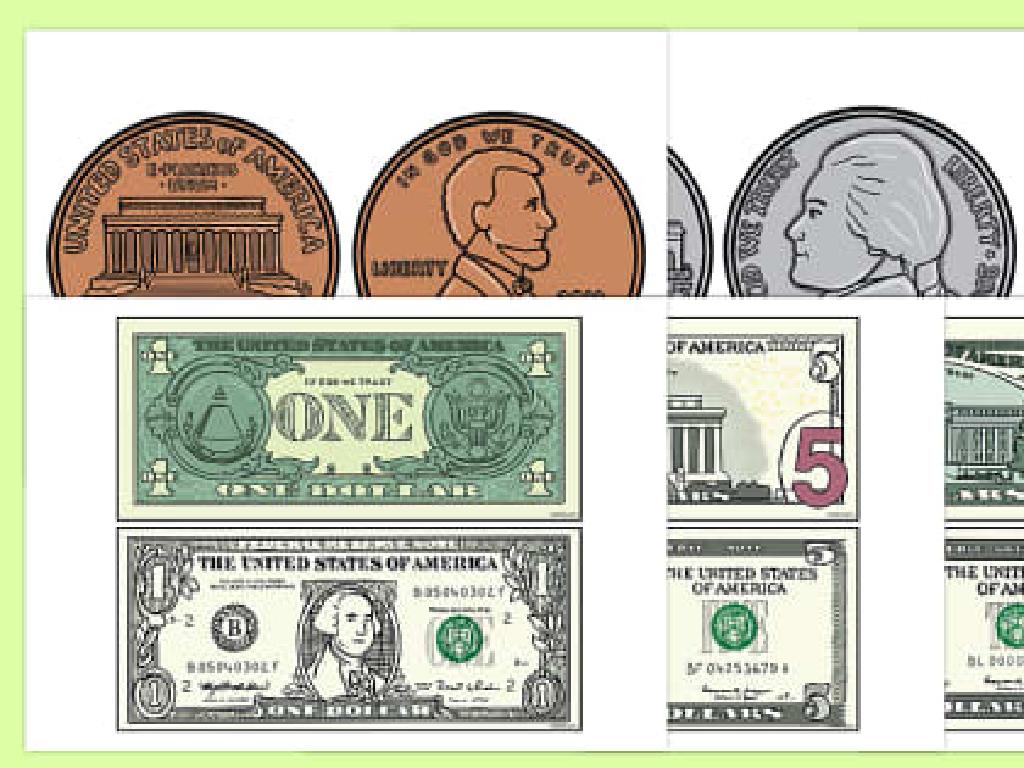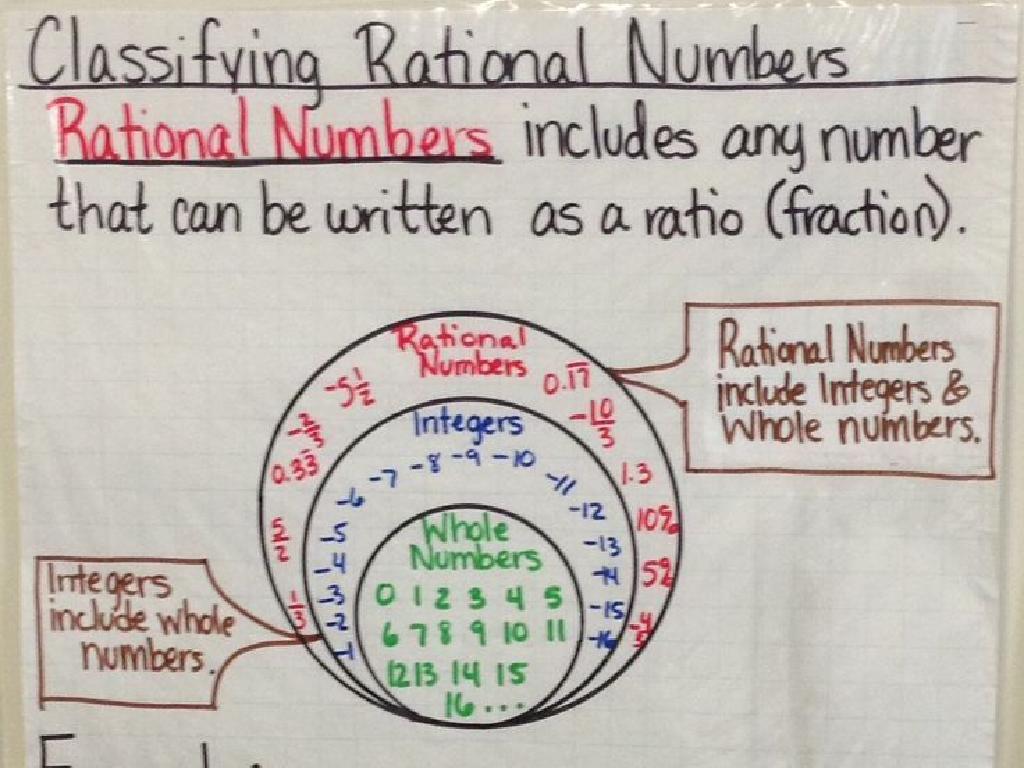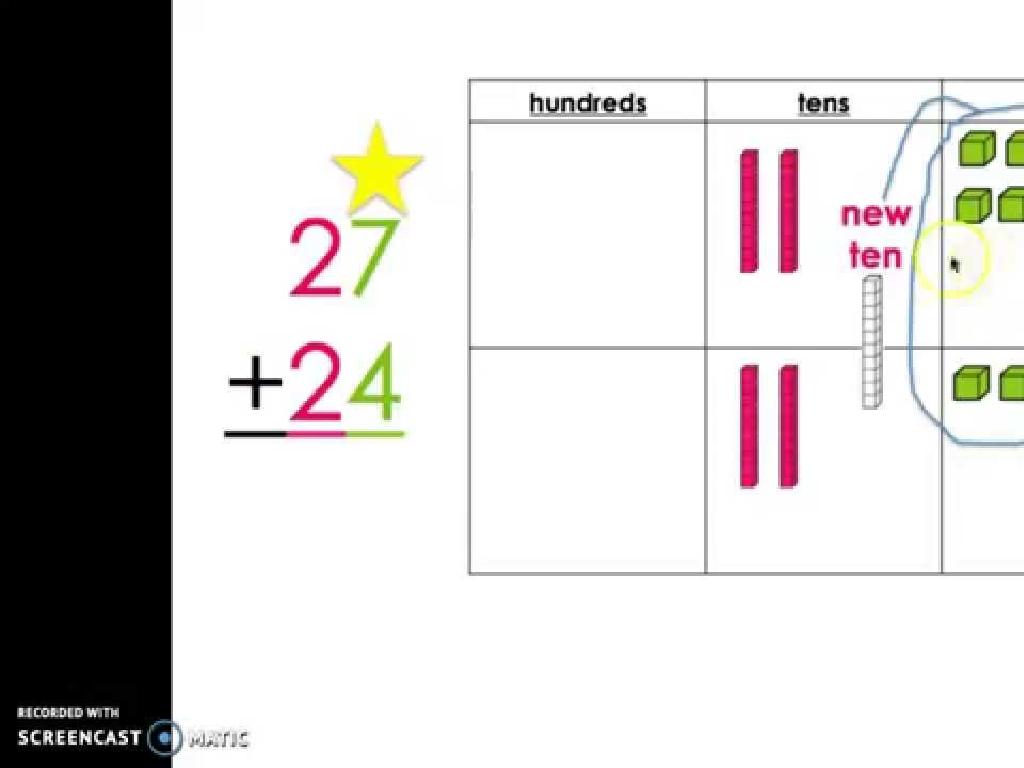Multiply 1-Digit Numbers By 3-Digit Or 4-Digit Numbers Using Area Models
Subject: Math
Grade: Fourth grade
Topic: Multiply By One-Digit Numbers
Please LOG IN to download the presentation. Access is available to registered users only.
View More Content
Multiplying Big Numbers with Area Models
– Explore multiplication as an adventure
– Understand area models
– Area models use rectangles to visualize multiplication
– Learn why it’s useful
– Helps with large numbers without memorizing tables
– Practice with examples
– Try 123 x 4 or 1567 x 3 using area models
|
This slide introduces students to the concept of using area models to multiply larger numbers by a single digit. Start by framing multiplication as an exciting adventure to engage the students. Explain that an area model is a visual tool that helps us break down multiplication into more manageable parts by drawing rectangles. Emphasize the practicality of this method, as it allows students to multiply large numbers without relying solely on memorization of multiplication tables. Provide examples such as 123 x 4 or 1567 x 3 and work through them step by step using the area model method. Encourage students to draw their own area models and practice with different numbers to solidify their understanding.
Multiplying with Larger Numbers
– Review: Multiplication basics
– Multiplication as repeated addition
– If we have 4 groups of 3, that’s 3+3+3+3
– Examples: 1-digit multiplication
– 7 x 4 is the same as adding 7 four times
– Introduce 3-digit by 1-digit
– Now let’s try 123 x 4 using an area model
|
Begin with a quick review of what multiplication is, emphasizing its connection to repeated addition, which they are familiar with. Show simple 1-digit multiplication examples to ensure understanding. Then, introduce the concept of multiplying larger numbers, specifically 3-digit numbers by a 1-digit number, using area models. This will set the foundation for understanding the process before moving on to 4-digit numbers. Use visual aids like an area model to demonstrate the multiplication process step by step. Encourage students to think of multiplication as building blocks to larger concepts.
Multiplying with Area Models
– What’s an Area Model?
– A visual tool to represent multiplication as the area of a rectangle.
– Visualizing Multiplication
– Breaks down larger problems into smaller parts.
– Example: 2-digit x 1-digit
– Multiply 23 by 4 using a rectangle split into tens and ones.
– Practice with Area Models
|
Introduce the concept of an area model as a visual representation of multiplication, using the area of a rectangle to illustrate the product of two numbers. Explain how this method helps in breaking down more complex multiplication problems into smaller, more manageable parts, making it easier for students to understand and solve them. Provide a step-by-step example of multiplying a 2-digit number by a 1-digit number using an area model, such as 23 x 4. Encourage students to draw their own area models and practice with different multiplication problems to reinforce the concept.
Multiplying 1-digit by 3-digit Numbers
– Understand 1-digit by 3-digit multiplication
– Break down numbers into place values
– Hundreds, Tens, Ones: 123 is 100 + 20 + 3
– Visualize with an area model
– Draw a rectangle, divide into sections for each place value
– Example: Multiply 4 x 123
– Area model shows 4 groups of 123 in a visual way
|
This slide introduces students to the concept of multiplying a 1-digit number by a 3-digit number using area models. Start by explaining the process of multiplication as combining equal groups. Then, guide students to break down the 3-digit number into hundreds, tens, and ones to simplify the multiplication process. Use an area model to visually represent the multiplication, which helps in understanding the concept of place value and addition in the process. For example, show how to multiply 4 by 123 by creating an area model that represents 4 groups of 100, 4 groups of 20, and 4 groups of 3, and then combine the results to find the final product. Encourage students to practice with different numbers and to draw their own area models to reinforce the concept.
Multiplying with 4-digit Numbers using Area Models
– Challenge: Multiply 1-digit by 4-digit
– Comprehend thousands in area models
– Area models help visualize large numbers
– Example: Multiply 3 x 4567
– Break 4567 into 4000, 500, 60, 7 and multiply each by 3
– Practice with different numbers
– Try multiplying 3 x 2345 or 2 x 6789 using area models
|
This slide introduces students to the concept of multiplying 1-digit numbers by 4-digit numbers using area models. Start by explaining the challenge and ensure students understand the significance of each digit in a 4-digit number. Use the example of 3 x 4567 to demonstrate how to break down the 4-digit number into thousands, hundreds, tens, and ones, and then multiply each by the 1-digit number. Show the area model representation for each step. Encourage students to practice with different numbers to solidify their understanding. Provide guidance on setting up their own area models and solving the problems step by step.
Practice Time: Multiplication with Area Models
– Let’s solve examples together
– Class practice problem
– We’ll work through a problem as a whole class
– Break down the numbers
– Split 3-digit or 4-digit numbers into smaller parts
– Use area models for multiplication
– Draw rectangles to represent the parts and multiply
|
This slide is designed for an interactive class activity where students will practice multiplying 1-digit numbers by 3-digit or 4-digit numbers using area models. Start by guiding the class through a few examples, demonstrating each step on the board. Then, present a practice problem for the class to solve together, encouraging participation. Emphasize the importance of breaking down larger numbers into hundreds, tens, and ones to simplify the multiplication process. Use area models to visually represent the multiplication, showing how each part of the number contributes to the final product. This hands-on activity will help solidify the students’ understanding of the concept. Prepare several different problems of varying difficulty to accommodate all learners and ensure everyone has the opportunity to engage with the material.
Group Activity: Exploring Area Models
– Split into groups for problem-solving
– Each group creates an area model
– Use graph paper to draw models for multiplication
– Present models to the class
– Share how you multiplied the numbers using the model
– Discuss various methods and answers
– Compare different strategies and learn from each other
|
This group activity is designed to foster collaborative learning and a deeper understanding of area models in multiplication. Divide the class into small groups and assign each a multiplication problem involving a 1-digit number and a 3-digit or 4-digit number. Provide graph paper and encourage students to draw area models to solve the problems. After completing the models, each group will present their approach to the class, explaining their process and solution. Conclude the activity with a class discussion on the different methods used, highlighting the benefits of using area models for multiplication. This will help students see the practical application of area models and appreciate the value of teamwork and shared knowledge.
Class Activity: Area Model Multiplication
– Draw an Area Model for 5 x 3482
– Sketch a large rectangle, divide it into sections for each digit of 3482
– Use colors for place values
– Assign a color for hundreds, tens, and ones to help visualize
– Explain your model to the class
– Describe how each part of the model represents the multiplication
– Reflect on the multiplication process
|
This activity is designed to help students visualize the process of multiplying a one-digit number by a multi-digit number using an area model. Provide students with colored pencils or markers to differentiate between hundreds, tens, and ones. Encourage them to draw a large rectangle and partition it according to the place values of the 3-digit number. As they present, they should explain how each section of their model contributes to the final answer. This will reinforce their understanding of place value and the distributive property. Possible variations for different students could include using different multi-digit numbers or changing the one-digit multiplier.
Wrapping Up: Area Models in Multiplication
– Recap of today’s lesson
We learned to multiply using area models.
– Benefits of area models
Area models visually represent problems, making multiplication easier to understand.
– Looking forward to more math
Excitement for upcoming math concepts and challenges.
– Practice makes perfect
Keep practicing with different numbers to master the skill.
|
Today, we’ve explored how to multiply 1-digit numbers by 3-digit or 4-digit numbers using area models. This visual tool helps students understand the concept of multiplication by breaking it down into smaller, more manageable parts. It’s particularly useful for visual learners and for explaining the distributive property of multiplication. As we prepare for our next math adventure, encourage students to continue practicing with area models. Reinforce the idea that practice is essential to becoming confident in multiplication. For the next lesson, hint at the introduction of new multiplication strategies or perhaps applying these skills to solve real-world problems.





